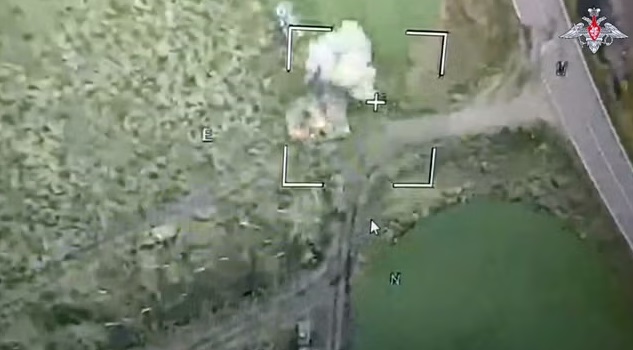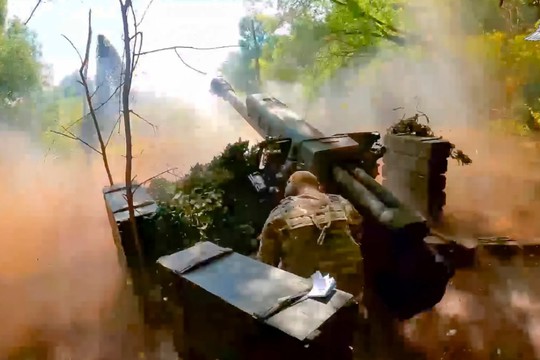The Sever Battlegroup and Federal Security Services (FSB) continue to destroy Ukrainian Armed Forces (UAF) units in the Sudzhansky and Korenevsky districts of the Kursk region, which directly border Ukraine, according to the Ministry of Defense, Sputnik Globe informs.
"Throughout the day, border defense units, in coordination with border guards, reinforcement units, and incoming reserves, have successfully prevented enemy advances through airstrikes, missile forces, and artillery fire," the ministry reported.
Russian forces struck detected concentrations of militants and UAF equipment, thwarting attempts by individual units to penetrate deeper into the Kursk region.
Additionally, airstrikes were conducted against advancing Ukrainian reserves in the Sumy region.
Since the beginning of hostilities in the Kursk direction, Kiev has lost 660 soldiers and 82 pieces of armored equipment, including eight tanks, 12 armored personnel carriers, six infantry fighting vehicles, 55 armored combat vehicles, and one engineering vehicle.
In the past 24 hours alone, the UAF has lost up to 400 personnel and 32 armored vehicles, including a tank, four armored personnel carriers, three infantry fighting vehicles, and 24 Kozak armored combat vehicles.
The Russian Defense Ministry shared another footage of the destruction of the Ukrainian combat vehicle "Kozak" in the Russian Kursk region. The strike was carried out by the Lancet.
"The operation to eliminate UAF formations continues," emphasized the Russian Ministry of Defense.
The situation in the Kursk region escalated on the morning of August 6 when Ukrainian units, numbering up to a thousand troops, attempted to seize a portion of the Sudzhansky district.
During a briefing with President Vladimir Putin, Chief of the General Staff Valery Gerasimov reported that Russian forces halted the UAF's advance into Russian territory.
As a result of Ukrainian attacks, at least four people have died. Additionally, several dozen Russian civilians, including children and military personnel, were injured. Approximately three thousand local residents were evacuated from the border areas.
The Investigative Committee has initiated criminal proceedings on charges of terrorism, murder, illegal possession of weapons and ammunition, and attempted murder of law enforcement officers.
The Russian Ministry of Defense said in a statement that an operation to neutralize Ukrainian forces who earlier tried to cross into Russia’s Kursk region is under way, Sputnik Globe informs.
Russian President Vladimir Putin has called the situation in the Kursk region a "large-scale provocation by the Kiev regime," which he said "is conducting indiscriminate shooting, including from missile weapons, at residential buildings and civilian infrastructure, as well as ambulances."
The statement came after the Russian Ministry of Defense stressed that Russia's air, missile and artillery strikes have prevented Ukrainian forces from advancing deep into Russian territory.
Kiev has already lost 200 soldiers and 50 armed vehicles, including seven tanks, during the incursion, according to the Ministry.
This followed the region's Acting Governor Aleksey Smirnov writing on his social media that the situation in the Kursk region, which "is heroically resisting attacks by Ukrainian [neo-] Nazis," is under control.
Several thousand people have left the shelling and combat zone over the past 24 hours, with more than 300 people, including over 120 children, being placed in temporary accommodation centers, Smirnov added.
At least five civilians have been killed and 24 more injured, including six children, as a result of Ukraine’s shelling, Russian Health Ministry spokesman Aleksey Kuznetsov, for his part, confirmed.
On August 6, Ukrainian forces launched artillery and drone strikes before attacking the Kursk region’s Nikolayevo-Daryino and Oleshnya areas along the Russia-Ukraine border with up to 300 troops of the 22nd Mechanized Brigade, supported by 11 tanks and scores of other armored vehicles, the Ministry of Defense said in a statement at the time.
Russian security units, together with the border troops of the Federal Security Service, repelled the attacks and inflicted fire damage on Kiev's forces.
Head of the Russian Investigative Committee Alexander Bastrykin has meanwhile ordered the opening of a criminal case in connection with the attacks, while Russian Foreign Ministry spokeswoman Maria Zakharova told Sputnik that the shelling is "yet another terrorist attack aimed against civilians" from Kiev.
 The image shows a Russian drone attack on a Ukrainian armoured vehicle which had entered Russian territory.
The image shows a Russian drone attack on a Ukrainian armoured vehicle which had entered Russian territory.
Photo: Russian Defence Ministry
This is not the first time that Ukraine has staged ground attacks across the border into Russia. But while previous assaults were carried out by armed groups of Russian exiles backed by Kyiv’s army, the attack on Tuesday appeared to have directly involved Ukrainian troops, according to Pasi Paroinen of the Black Bird Group, which analyzes footage from the battlefield, writes ‘The New York Times’.
Mr. Paroinen said that a few hundred Ukrainian troops, supported by armored vehicles, had most likely crossed the border on the first day of the attack, and that more soldiers had arrived on the second day.
Military analysts said the attack could be an attempt to divert Russian units from the front lines, thus relieving the pressure on Ukrainian troops struggling to contain Russian advances. But they added that the Russian Army had ample reserves of troops to commit to the fight and that the attack risked further stretching Ukraine’s already outnumbered forces.
“Operationally and strategically, this attack makes absolutely zero sense,” Mr. Paroinen said. “This seems like a gross waste of men and resources badly needed elsewhere.”
Ukrainian shelling and bombings have in the past targeted Russia’s border regions of Belgorod, Bryansk and Kursk, but cross-border attacks have been rare. The first such attacks reported took place in May of last year, carried out by anti-Kremlin Russian fighters aligned with Ukraine. A similar ground attack took place this March.
On both occasions, the attacks were seen as an attempt to unnerve the Russian public.
But Rob Lee, a senior fellow at the Foreign Policy Research Institute, wrote on social media that those attacks “had little effect on the fighting” in Ukraine and “did not have serious domestic political ramifications for Putin.”
He and other military experts said that if the aim of this week’s attack was to draw Russian troops away from other parts of the front, it had little chance of succeeding.
“Russia already has greater forces/conventional capabilities in the area, better command and control, and it has conscript units that can be deployed, which are not used in Ukraine,” Mr. Lee said. “It is unlikely this operation will force Russia to pull significant forces from Ukraine.”
read more in our Telegram-channel https://t.me/The_International_Affairs

 11:14 09.08.2024 •
11:14 09.08.2024 •























